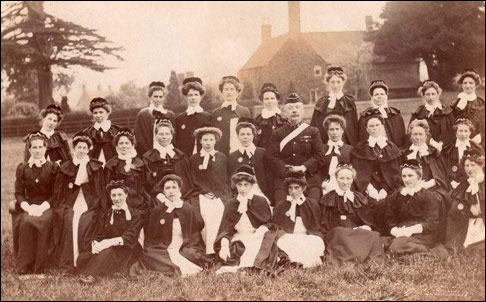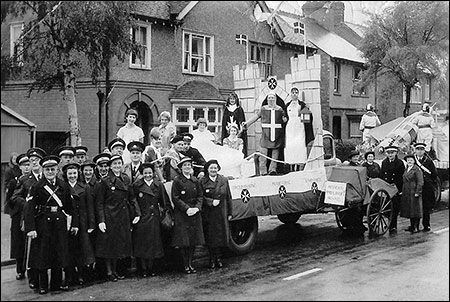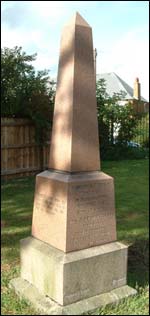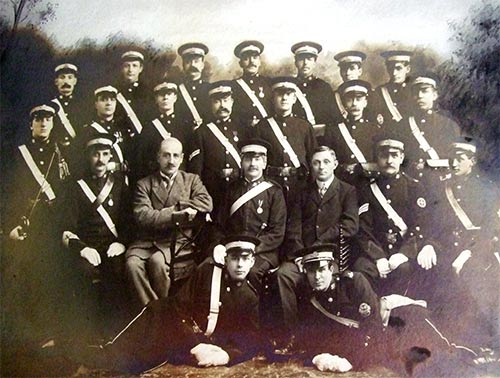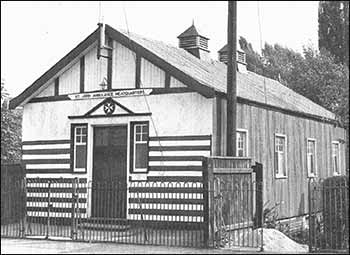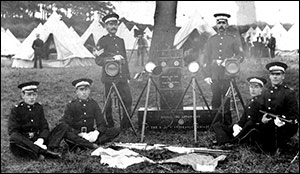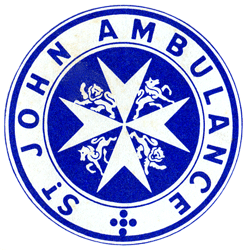|
|||||||||||||||||||
| Extracted from a booklet produced to raise funds for a new ambulance, in 1980 |
|||||||||||||||||||
|
St John Ambulance Brigade
|
|||||||||||||||||||
|
|||||||||||||||||||
|
|||||||||||||||||||
|
The St.John Ambulance Rushden Division In 1896 about 21 men of Rushden formed the first division of the St. John Ambulance Brigade in the town. Men whose descendants' names are still well known in Rushden such as Bugby, Knight, Childs, Eagles, Mackness, Johnson, Gibbs, Faulkner, Seckington, Hanking, Cave, Wright and Burnside. The first meeting was at Alfred Street School and since then men and women have been meeting each week to learn first aid and nursing so that they can help those injured, suffering and in distress. Over the years you have seen them at most sporting events, football, rugby, garden fetes, carnivals and at The Ritz, church fetes etc. All these thousands of hours are given voluntarily in rain, sun or snow. "The St. John movement has been kept going by donations given by organizations and people of Rushden and we would like to thank everyone concerned in giving us their support", so reads a citation which hangs on the wall in the St. John Ambulance Head Quarters, in Station Road, Rushden. When one looks back over those past years it is difficult to realise just what effort has been put into the service of mankind in this town. Let us look back at the beginning, which is comparatively easy since the division still has in its archives the original secretary's book dated 1896. A letter addressed to Miss Sartoris of Rushden Hall invites her to present the certificates to the members at a social evening in Alfred Street School the letter was signed then by the Hon. Sec. of the division Mr. H. M. Seckington. Even today one needs a certificate in First Aid before one can join the Brigade. The original First Aid course lectures were given by Dr. Baker the first Divisional Surgeon. Now let’s look at the work the division performed. The first recorded Public Duty performed was in London June 22nd 1897 The Diamond Jubilee of Queen Victoria, five members attended and each received a medal commemorating the event. The first recorded public duty performed in town was at the Athletic Club and Institute Sports Day on July 13th 1897 and equipment had to be borrowed for this event from the Wellingborough St. John Ambulance. Apart from being available to treat people at functions they also had to be prepared to treat people at home and take people to hospital if required. The method of taking anyone to hospital was different then as it is now, first of all one had to fetch the ambulance man out of his work, propably a shoe factory, and he had to get the ambulance a wheeled litter, push it to the patient and load up. If that was not a trial in itself wait for the journey to hospital. The patient would have been pushed through the town on the litter to the railway station and have to wait for a train to take them to Wellingborough, where they would change trains for Kettering Cottage Hospital. The ambulance man then had to bring the litter back home to Rushden; Sergeant Prigmore did much of this work. The first recorded patient on the litter was a woman injured in an attempted murder on July 6th 1897. Uniforms were made locally and all tailors in the town seemed to receive a standard letter asking for a quote to be made for making the uniforms, nowadays the uniform buying and selling is arranged at our international stores department at Clerkenwell, London. Each division is responsible for the raising its own funds and that is usually initiated by their president. The first president to the Rushden division was Mr. F. Norman (solicitor).
Ten men camped locally for training and passed their First Aid proficiency whilst at camp. At the turn of the century members were despatched to the Boer War as orderlies and a certificate acknowledging their work was presented to them. Two persons never returned from their work as volunteer Medical Orderlies and a monument was erected as a memorial to them near the entrance to Rushden Cemetery.The nursing division commenced its work in 1901, with a strong band of members, these women gave nursing assistance to townsfolk in their own homes. The work continued into the new century and photographs which the division still have, show efficient personel with nursing certificates and many years service behind them including a bugler. Members were also attached to the Royal Naval Auxiliary Sick Berth Reserve, an attachment which went on for many years. |
|||||||||||||||||||
A report of the Rushden Division of 1920 shows that in the Men’s Sections there were 27 private ranks, 4 corporals, 4 sergeants, 1 superintendent and 1 Honorary Surgeon, whilst the nursing division there were 8 nursing sisters, 10 First Aid Members, 1 First Officer, 1 Lady superintendent and 2 Honorary surgeons. In the interesting account of the divisional activities it gives information that the transport work to the County Hospital (Northampton) which had been until July 1919 executed by the members with aid of the wheel litter, was now being more expeditiously carried out with the motor ambulance although several minor cases had been removed from the local cottage hospital on the wheeled litter. Also in that year Dr. H. W. Davies and Dr. W. B. Audland held a First Aid Class and long service medals were presented to Sergeants Cashmore, Abbott and J. Bugby, Corporal Ambridge and Private Tassell. The successive reports to annual meetings in the between war years gives interesting information and notable people were generous in the times of a national depression. 1928 - The division won many First Aid trophies. The divisional team was made up of Ambulance Officer Timpson, Corporal Harris, Privates Murdin, Ekins and Woods. A police team was also involved they were Privates Roche, Osborn, Jefcoate, Hayes and Pratt. Members of the Royal Naval Sick Berth Reserve attended the R.N. Hospital at Chatham for their annual training. The annual inspection of the division was held at Northampton on July 14th. Major General Sir Percival S. Wilkinson was the chief commissioner and inspecting officer. In successive years R.N.A.S.B. training was held at Gosport, Haslar or H.M.S. Cambrain at Chatham. In 1938 a course of Air Raid Precautions Lectures were given by Corps. Supt. J. M. Bailey and Div. Supt. G. W. Timpson, 23 members passed for this certificate. In the October Dr. Davies gave a course of lectures in First Aid with the A.H.P. casualty services with nearly 100 persons attending. The following members of the R.N.A.S.B. reserve were called up for active service during the crisis W. A. Robinson, T. W. Elliott, A. Sargent, C. Green and G. Bazely but 2 weeks later returned due to a sense of false security following the prime minister’s visit to Munich to see A. Hitler. August 1939 five thousand R.N.A.S.B. reservists were required for service, Privates C. Baker and B. C. Harris were the first from Rushden to go. They were drafted from Portsmouth and went on the home fleet to Scarpa Flow on Hospital ship number 3. They were in the North Sea when war was declared. Later many members were to serve in the R.N.A.S.B. as well as the reserve and obtained the ranks as Chief petty Officer and Petty Officer. At home the nursing division set up first aid posts in the town at Moor Road School and were visited by H.R.H. The Duchess of Gloucester, they also provided personnel for the hospital in Wellingborough. In 1941 the castle ward opened in the Park Hospital (Isebrook) the elderly patients were moved in assisted by nursing auxiliaries of the Rushden Division of St. John. Then two weeks later they were moved out at short notice only for the auxiliaries to set out 200 collapsible beds, made them up and sorted out all the cutlery ready to receive 200 wounded soldiers off the evening train which arrived at Wellingborough Station. At home members were available as usual for the accidents which occurred. Two men from the division Pte F. Mitchell and L. Tobin were involved in a dramatic rescue after a U.S.A.F. Flying Fortress which was returning from Germany to Chelveston suddenly hit a tree, crash landed and caught fire in Wymington. The 2 Ambulance men dragged out 8 airmen and treated the injured but due to security reasons news of the event was not recorded until six months later when it was heard on the wireless and printed in the National Papers.
At this time the divisional strength was 52, of which 24 were on active service. It was also during the war that the nursing cadet division commenced their work with the St. John. The first superintendent was Mrs M. Jones. In 1946 the Ambulance Division received its Jubilee Certificate for 50 years continuous work to the community and the Post War work commenced. Personnel maintained a relief service for the Rushden Motor Ambulance Association by manning the service at weekends, and the vehicle was fitted with two way radios linking into the County Ambulance Service system. The ambulance used to be kept at the Lightstrung Garage and for many years this service continued until 1964 when the new ambulance station was built in Station Road which provided a 24 hour cover 7 days a week. Not only was the work thriving in Rushden but also in other parts of the world notably Canada. The St. John in Canada was commenced when one division was inaugurated there. Mr William Loveday registered the first division and through the years the work there increased to snow patrols in desolate areas and kindred work. The efforts of this man were recognised by the Order of St. John as eventually he became a Knight of St. John and Governor of the Royal Victoria District Hospital London Ontario. He did not forget his old friends in Rushden particularly Sergeant William Burgess, later he came to Rushden to visit friends an opportunity the division did not miss to entertain him, as he was an Irthlingborough man. 1947 the division escorted 2,000 employees of John White Footwear in 66 coaches to the Trades Fair in London to see the 2 millionth pair of shoes on show. Quite a formidable sight is captured on photographs, with the coaches leaving Big Ben in the evening. 1951 saw the beginning of the Ambulance Cadet Division their first superintendent was Mr. W. H. Jones. The ambulance division also commenced many years' service to Motor Racing at Silverstone, treating celebrity drivers following accidents being a common thing. In 1953 the division collected clothing to help East Coast flood victims. In the mid 1950’s cycle racing appeared on the scene to raise cash for the division and for many years this continued thanks to the organization of Mr. Sidney Cottingham. About 100 riders would set off from Rushden Head Quarters, and ride 70 miles throughout the country roads to Rushden to raise £100's for funds to help the division; funds also were raised by Rushden Query Club. Sunday October 21st 1962 was a memorable day for the region when 6 counties attended a special Service of the Order of St. John at Peterborough Cathedral. Over 2,000 members attended and the band of the 4/5th Battalion Northamptonshire Regiment lead a parade of High Ranking Officers and Members of the St. John to the Cathedral. A fanfare of the Royal Horse Guards heralded the arrival of the Officers of the Order of St. John into the Cathedral. The order of St. John of Jerusalem is the foundation of the St. John Ambulance. During the Mid 1960's the division was again successful in winning many competitions and eventually competing at Regional Level against teams from other counties. The team comprised of Corporal P. Cox, Ambulance men: G. Robinson, G. Hunt and R. Mullis. 1967 - The division sold their ex navy ambulance and purchased another by subscription from townsfolk which was organized by L. G. Roberts, their president at that time. 1969 - The division organized a tote for the funds together with Irchester Division and this has managed to keep the division financially viable. Thanks are due to all those involved in the tote. 1970 - The St. John in the U.K. asked members if they could provide personnel for a relief team to go to Nigeria at the termination of the Biafran war; 200 volunteered some of whom came from Rushden Division. In fact only a small team actually went but contingency plans were available if a larger team was necessary. 1970 - Banger Racing arrived on the scene and many hours were given to this scene, also to Drag Racing from 1964 - 1973, and the division commenced a satisfying duty of escorting the disabled of the town to holidays and day outings; this work still continues. 1974 - The Cadet division managed, with the help of Mr R. K. Wilbur to build their own Mirror sailing dinghy as part of their work for the Grand Priors Badge the highest award in the cadet movement. 1975 - The officer of the division Mr G. Robinson went on duty to a first aid post set up in the Vatican to assist in treatment of the sick in Rome during Holy Year in conjunction with the Sovereign Military Order of Malta, the European equivalent of the St. John Ambulance. Disaster training was emphasized in the 1970's and many practice lessons were used in this way. Training for major accident work is a necessary part of the work in complementing the work of the rescue crews in such events of disaster. 1975 - The division took possession of a replacement ambulance and this was converted for modern day Ambulance work by Professional ambulance men and many miles it travelled performing duties all over the county. In 1976 the division was instrumental in setting up the rescue system at Empingham Reservoir. In 1977 the ambulance cadet division organised (by their superintendent K. Robinson), a bugle and drum band and instruments were purchased from the St. John Band at Banbury. Training was given by Mr R. Clayton who was well known in the town for the work with the Salvation Army and Scouting, apart from being an old member of the St. John in Rushden, and a Petty Officer in the R.N.A.S.B. during the second World War. 1978 - The division organized the building of its mobile unit, ex-cadet S. Moore arranged the work for this. The Lions Club were financiers to this project. This year also saw the division’s involvement in the aeromedical work of the St. John. This department assists in the repatriation of injured British citizens whilst on holiday abroad. Margaret Whiteman was presented with a Serving Sister Award, the highest available within the Brigade. Recently the division has been on duty at National Front demonstrations, on Police Ambulances during strikes, attended Spalding Bulb Festival and state occasions such as Jubilees and Funerals as well as county and town events. We have a strong team of first aiders headed by Div. Supt. G. Hunt and Dr. Coles. The members are recognized First Aiders with the Health and Safety Executive. So, you may understand, the work of the St. John in Rushden is doing a vital job in caring for the sick and injured in the town, county and world-wide. We hope you can help us to help you in future by supporting us.
|
|||||||||||||||||||
